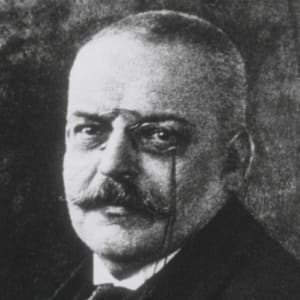
Alois Alzheimer
Alois Alzheimer was a German psychiatrist who discovered the pathological condition of dementia and diagnosed the disease that bears his name.
Synopsis
Alois Alzheimer was born in Marktbreit, Germany, in 1864, and showed an early aptitude for science. After obtaining his medical degree, he worked in hospitals in Frankfurt, where he met Auguste Deter, a 51-year-old woman suffering from progressive short-term memory loss. He was eventually able to isolate the pathological causes of severe dementia, work so extensive that the condition became known as Alzheimer's disease.
Early Years
Alois Alzheimer was born on June 14, 1864, in the small Bavarian town of Marktbreit, Germany. He excelled in science and attended the universities of Berlin, Tübingen and Wurzburg, where he wrote his doctoral thesis and graduated with a medical degree in 1887. His parents had taught him that the strong look after the weak, and he set out to dedicate his life to that maxim.
Work on Pathology of the Nervous System
In 1888, Alois Alzheimer began his residency at the Hospital for the Mentally Ill and Epileptics in Frankfurt, Germany, headed by Emil Sioli, a progressive psychiatrist who put "no restraints" on Alzheimer's work. He stayed there for seven years, eventually being promoted to senior physician. During this time, Alzheimer studied psychiatry and his passion of neuropathology. He partnered with Franz Nissl, the distinguished neurologist, and together the pair conducted extensive investigations on the pathology of the nervous system. Their work resulted in the six-volume Histologic and Histopathology Studies of the Cerebral Cortex, published between 1906 and 1918.
In April 1894, Alzheimer married Cecilia Geisenheimer, and the couple went on to have three children. The marriage made him financially independent, helping him support his own research. Cecilia died in 1901, and Alzheimer's single younger sister, Elisabeth, came to Frankfurt to raise the children.
Studying Dementia
In 1895, Nissl moved to Heidelberg, Germany, to work with the distinguished German psychiatrist Emil Kraepelin. Alzheimer stayed in Frankfurt, working on a wide range of subjects, including manic depression and schizophrenia. In 1901, he met Auguste Deter, a 51-year-old woman with strange behavior symptoms and increasing short-term memory loss. Her condition rapidly deteriorated into severe dementia. The patient would become his obsession over the coming years.
In 1902, Kraepelin invited Alzheimer to work with him in Heidelberg, and one year later they moved the operation to the university psychiatric clinic at Munich. During this time Alzheimer studied the Deter case and conducted microscopical investigations on other diseases, including Huntington's chorea and epilepsy.
In 1906, Auguste Deter died, and Alzheimer had her patient records and brain brought to Kraepelin's lab in Munich. During an autopsy, Alzheimer identified a number of pathological conditions, including shrinking of the cortex and the presence of neurofibrillary tangles and neuritic plaques. The plaques and tangles were distinctive enough to warrant a diagnosis of senile dementia, which became known as Alzheimer's disease.
During Alzheimer's tenure at the psychiatric clinic in Munich, students from various countries attended his classes and marveled at his teaching. He was well known for his hands-on style, moving among the different microscope workstations and discussing each student's observations. Years later, many would recall the sight of Alzheimer bowed over a microscope with his pince-nez glasses dangling around his neck and a cigar in his mouth, which he would set on the workstation table to conduct his explanations. It was said that at the end of the day there would be a cigar stump at nearly every student's workstation.
Final Years
On July 16, 1912, King Wilhelm II of Prussia appointed Alois Alzheimer professor of psychiatry at the University of Breslau (now Wroclaw, Poland). Though Alzheimer suffered from rapidly deteriorating health, he devoted the last three years of his life to research and clinical work. He died in Breslau (now Wroclaw), Poland, on December 19, 1915, at the age of 51, from cardiac failure—a result of an inflammation of the inner layer of the heart.




